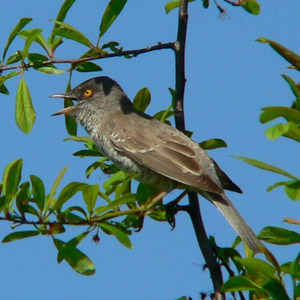Pratique | Débuter
Fauvette épervière et Pie-grièche écorcheur : une alliance efficace

Fauvette épervière (Sylvia nisoria) mâle en Pologne.
Photographie : Artur Mikołajewski / Wikimedia Commons
Introduction
Plusieurs exemples d’associations entre deux espèces d’oiseaux durant la période de nidification sont connus, par exemple entre le Grèbe à cou noir et les Mouettes rieuses. Généralement, seule l’une des deux bénéficie de ce rapprochement et profite de l’efficacité du comportement défensif de l’autre. La Pie-grièche écorcheur (Lanius collurio) et la Fauvette épervière (Sylvia nisoria) nichent aussi fréquemment l’une près de l’autre. Pour certains ornithologues, cette proximité ne serait due qu’à leur préférence pour le même type d’habitat, tandis que d’autres estiment que seule la fauvette tirerait profit du bec crochu et de l’agressivité de sa voisine. Mais il semble qu’en fait cette association soit bénéfique pour les deux passereaux.
Abstract
Several examples of associations between two species of birds during the nesting period are known, for example, between the Black-necked Grebe and Black-headed Gulls colonies. Typically, only one of the two benefits from this situation, taking advantage of the aggressiveness and the defensive behavior of the other. The Red-backed Shrike (Lanius collurio) and the Barred Warbler (Sylvia nisoria) frequently breed close together. For some ornithologists, this proximity is due to their preference for the same type of habitat, while others believe that only the warbler benefits from the hooked beak and the aggressiveness of the Shrike. But it seems in fact this association is beneficial for both passerines.
Poursuivez la lecture de cet article, en vous abonnant dès maintenant !
Découvrez les Archives d’Ornithomedia.com
Pour seulement 10,00 €TTC/an (ou 6,00 € les 6 mois)
Profitez de plusieurs centaines d’articles en accès illimité et sans aucun engagement.
Compléments
À lire aussi sur Ornithomedia.com
- Les pies-grièches mâles empalent mieux que les femelles
- La Pie-grièche grise, le boucher de l’avifaune européenne
- Le Döberitzer Heide, au pays de la Fauvette épervière
- Des Grands Hérons se rapprochent de Pygargues à tête blanche pour nicher
- Le Faucon crécerellette et le Choucas des tours peuvent coopérer pour nicher
- Observer les oiseaux à Vienne et dans les environs
- Identifier deux sous-espèces de la Pie-grièche grise, les Pies-grièches méridionale et des steppes
- Le houspillage (ou « mobbing ») chez les oiseaux
Ouvrages recommandés
- Le guide Ornitho de L. Svensson et al
- Shrikes and Bush-Shrikes: Including Wood-Shrikes, Helmet-Shrikes, Flycatcher-Shrikes, Philentomas, Batises, and Wattle-Eyes de Tony Harris et Kim Franklin (Illustrations)
- Shrikes: A Guide to the Shrikes of the World de Norbert Lefranc et Tim Worfolk (Illustrations)
Sources
- Marcin Polak, Maciej Filipiuk (2014). Ornis Polonica. Preferencje siedliskowe jarzębatki Sylvia nisoria i gąsiorka Lanius collurio na Roztoczu Środkowym. Orni Polonica (55). Pages : 22-33. www.ornis-polonica.pl
- Stanisław Kuźniak, Jan Bednorz et Piotr Tryjanowski (2001). Spatial and Temporal Relations between the Barred Warbler Sylvia nisoria and the Red-Backed Shrike Lanius collurio in the Wielkopolska Region (W Poland). Acta Ornithologica, 36(2). pages : 129-133. www.bioone.org
- Polak, M. (2012). Habitat preferences of the sympatric barred warbler (Sylvia nisoria) and the red-backed shrike (Lanius collurio) breeding in central Poland. Annales Zoologici Fennici (49). Pages : 355–363. www.bioone.org
- Artur Golwaski (2007). Does the Red-Backed Shrike (Lanius collurio) benefit from nesting in the association with the Barred Warbler (Sylvia nisoria) ? Polish Jorunal of Ecology (55). Pages : 601-604. pje.miiz.waw.pl
- Paul Isenmann, Guillaume Fradet (1995). Is the nesting association between the Orphean Warbler (Sylvia hortensis) and the Woodchat Shrike (Lanius senator) an anti-predator oriented mutualism? Journal für Ornithologie. Volume 136, numéro 3, pages : 288-291. Link.springer.com
- Marcin Polak (2013). Comparison of nest defence behaviour between two associate passerines. Journal of Ethology. Volume 31, numéro 1, pages : 1-7. Link.springer.com




Aucun commentaire sur ce sujet
Participer à la discussion !